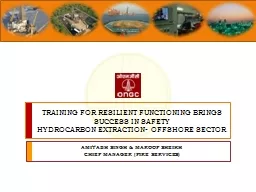PPT-TRAINING FOR RESILIENT FUNCTIONING BRINGS SUCCESS IN SAFETY
Author : beastialitybiker | Published Date : 2020-10-22
HYDROCARBON EXTRACTION OFFSHORE SECTOR AMITABH SINGH amp MAROOF SHEIKH CHIEF MANAGER FIRE SERVICES 2 Introduction Asia is the most disaster prone continent 90
Presentation Embed Code
Download Presentation
Download Presentation The PPT/PDF document "TRAINING FOR RESILIENT FUNCTIONING BRING..." is the property of its rightful owner. Permission is granted to download and print the materials on this website for personal, non-commercial use only, and to display it on your personal computer provided you do not modify the materials and that you retain all copyright notices contained in the materials. By downloading content from our website, you accept the terms of this agreement.
TRAINING FOR RESILIENT FUNCTIONING BRINGS SUCCESS IN SAFETY: Transcript
Download Rules Of Document
"TRAINING FOR RESILIENT FUNCTIONING BRINGS SUCCESS IN SAFETY"The content belongs to its owner. You may download and print it for personal use, without modification, and keep all copyright notices. By downloading, you agree to these terms.
Related Documents














